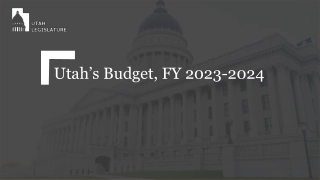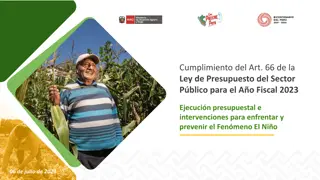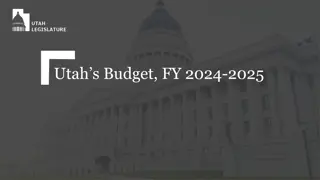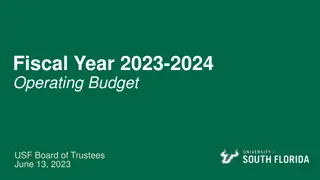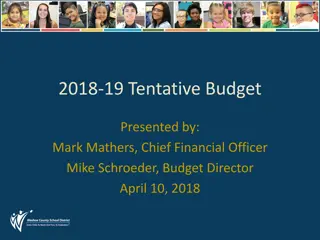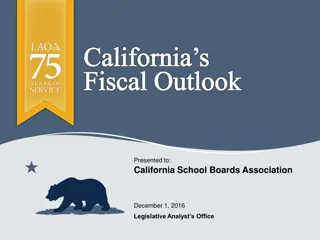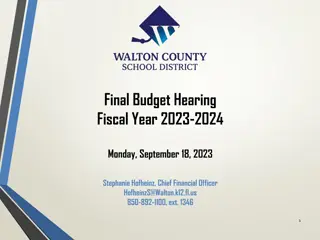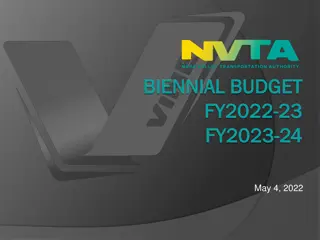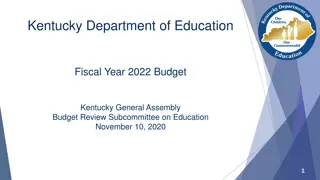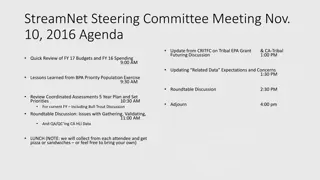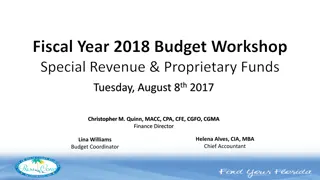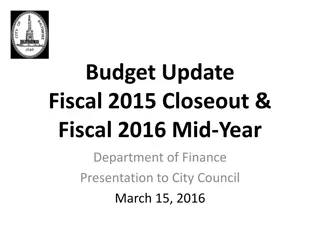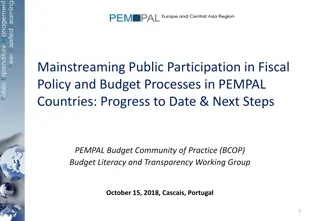Fiscal Year 2016 Budget and Statement of Work Discussion
Preliminary discussions and recommendations regarding the Fiscal Year 2016 budget and statement of work. Includes budget issues, 2014 and 2015 budget comparisons, steering committee recommendations, and executive committee budget discussions. Focus on budget guidance, funding allocations, and proposed adjustments for the upcoming year.
Uploaded on Sep 15, 2024 | 1 Views
Download Presentation

Please find below an Image/Link to download the presentation.
The content on the website is provided AS IS for your information and personal use only. It may not be sold, licensed, or shared on other websites without obtaining consent from the author. Download presentation by click this link. If you encounter any issues during the download, it is possible that the publisher has removed the file from their server.
E N D
Presentation Transcript
FISCAL YEAR 2016 BUDGET AND STATEMENT OF WORK PRELIMINARY DISCUSSION RECOMMENDATIONS/CHANGES ? GUIDANCE TO STEERING COMMITTEE BY APRIL 1?
BUDGET ISSUES AND DISCUSSION 2014 budget was $2,084, 576 same as 2013 (Permanent shift of $50,000 from PTAGIS) Need to get Baseline budget proposals from all partners; Personnel costs ? Other expenses or savings? Early budget guidance from BPA? Cost reductions at PSMFC last year to fund partner projects should be good for one more year. After that??? Executive Committee Discussion: BPA budget guidance, requests for additional funding, cost savings, or other adjustments as we built next budget and SOW?
2015 StreamNet Budget Indirect $84,052 PSMFC $544,386 $1,456,139 States & Tribes
FY 14 and 15 Budgets; Building the 2016 Request (*15 & draft 16 PSMFC budgets include $17,920 for WDFW seasonal) FY PSMFC* CCT IDFG MFWP ODFW USFWS WDFW* INDIRECT TOTAL 2014 $647,812 $90,000 $265,580 $153,115 $421,859 $18,200 $387,759 $100,251 $2,084,576 2015 $544,386 $90,001 $301,638 $168,877 $474,461 $18,200 $402,961 $84,052 $2,084,576 ? ? ? ? ? ? ? (11.82% and 1.43%) 2016 (Request) $553,774
STEERING COMMITTEE RECOMMENDATIONS ? WDFW: BPA should fund a Data Steward position in Wenatchee. Est: $174,400 (116,200 annual) WDFW: BPA should fund a Data Steward position in the Snake River Basin. Est: ($116,200 annual) WDFW: Outfit fixed data collection sites such as adult and juvenile fish traps in the Lower Columbia, Upper Columbia, and Snake regions with waterproof, ruggedized tablets that interface with existing radio frequency identification (RFID) readers for PIT tag detection. Automate data transfer from these collectors to HQ systems of record and receiving customers like StreamNet and BPA via subscriptions cloud service base mobile application. Est: $60K-80K ($15-$20K annual)
EXECUTIVE COMMITTEE BUDGET DISCUSSION BPA BUDGET GUIDANCE? BUDGET CONCEPTS & ISSUES FOR NEXT CONTRACT?
DISCUSS STATEMENT OF WORK FOR 2016 Last year focus was simplification of reporting Reduced to 20 work elements from 38 in 2014 Tried to focus on priorities; (Coordinated Assessments, Secure Data Repositories, Support of data management staff & programs in states and tribes, Regional Coordination) Today want to discuss any major changes for 2016
STREAMNET PROGRAM THEMES Support data management personnel & systems in partner agencies and tribes Provide a regional coordination forum for fish data management issues (i.e. CA) Work to identify the data management priorities of regional fish and wildlife managers Once priorities are established, work to develop efficient data flow Develop protocols for data sharing Help to secure data in accessible data repositories, provide a repository where others unavailable Decide what to do about historical datasets
TRADITIONAL STREAMNET DATA ? Long history of trends; redd counts, barriers, distribution, etc. Updating of these largely stopped over last two years due to prioritization of CA What should we do with long term datasets? Traditional data are generally also available through links to state and tribal data systems, often partially supported by BPA thru StreamNet funding Standardized Regional Data sets may be useful to maintain for regional analysis and comparison (i.e. long term fish trend datasets collected in the vicinity of habitat projects) Suggestion: next proposed SOW include resumption of maintenance of highest level of importance traditional data, as determined by a poll of StreamNet Steering Committee members and other interested individuals and reported back to you
Summary of data currently in StreamNet 9 March 2015 Data Category Adult Return-Est. of Spawning Populations Adult Return-Redd Counts Adult Return-Spawner Counts Adult Return-Spawner/Recruit Estimates Dam/Weir Counts (Adult or Juvenile) Estimates of juvenile populations Facilities - Barriers (potential) Facilities - Dams Facilities - Hatcheries Fish Counts Fish Distribution Harvest - Freshwater/Estuary Harvest - Marine Landings Hatchery - Returns Maps (pre-built) Photographs Protected Areas Available Data 3,503 Trends 4,946 Trends 5,619 Trends 30 Trends 584 Trends 130 Trends 64,258 Barriers 7882 Dams 537 Hatcheries 77 Trends 26,319 Streams 2,708 Trends 579 Trends 1,093 Trends 398 Maps 1,065 Photos 29,524 Records Years 1901-2013 1901-2013 1944-2013 1938-2006 1925-2013 1991-2012 n/a n/a n/a 1953-2012 n/a 1894-2012 1950-1996 1906-2013 n/a n/a n/a Observations 23,267 46,335 35,370 1,116 14,609 485 549 63,621 41,493 7,198 10,371
RECOMMENDATIONS ? Support the development and deployment of emerging technologies in fisheries through sponsorship of workshops and through funding, purchasing, development, and testing of these technologies by partners Seek out efficiencies and new sources of revenue. Where appropriate, recommend increases in traditional funding and support, as needed to complete established priorities Ensure that data collected and managed using BPA funding is secured in approved repositories Provide information to the public: StreamNet take on tasks more formally of maintaining back end databases for NPCC (Protected areas, facilities, dashboards, HLIs automate and maintain data flow?) Focus and prioritize the CA Project (To be discussed in detail later) Evaluate and prioritize updating traditional StreamNet data sets to reflect an emphasis on those that add value to ongoing regional O&M efforts Where traditional data is needed in support of regional priorities (i.e. resident fish data for NPCC indicators and dashboards), Support data management in agencies and tribes to automate and streamline data flow Take on regional task of identifying and maintaining standard population names, codes, and geographic locations?
STEERING COMMITTEE SOW RECOMMENDATIONS ? (INPUT TO DATE) WDFW Budget Proposals: Data Steward position in Wenatchee MFWP: Related to (Regional prioritization) Recommend BPA or the StreamNet Executive Committee clearly convey to agencies the importance of contributing to regional efforts. This will assist in gaining acceptance and buy-in from agency managers and biologists. Data Steward position in the Snake River Basin Outfit fixed data collection sites with waterproof, ruggedized tablets that interface with existing radio frequency identification (RFID) readers for PIT tag detection. Automate data transfer from these collectors to HQ systems of record and receiving customers like StreamNet and BPA via subscriptions cloud service base mobile application
EXECUTIVE COMMITTEE SOW DISCUSSION CONCEPTS & ISSUES FOR NEXT STATEMENT OF WORK?
BACKGROUND SLIDES
Support transfer of data into secure & accessible repositories 159. Transfer/Consolidate/Regionally Standardize Data ($42,365.00 2.03 %) B Maintain SN Data Store as a secure and accessible repository 160. Create/Manage/Maintain database ($3,975.00 0.19 %) C CA data - coordination 189. Regional Coordination ($93,295.00 4.48 %) D CA data - DES and database 160. Create/Manage/Maintain database ($128,450.00 6.17 %) E CA data - compile data 159. Transfer/Consolidate/Regionally Standardize Data ($175,675.00 8.43 %) F CA data - automated data exchange 160. Create/Manage/Maintain database ($89,200.00 4.28 %) G CA data dissemination 161. Disseminate Raw & Summary Data and Results ($24,200.00 1.16 %) H Compile traditional StreamNet data and explore possible expansion of a CA-like process for resident fish and other fish metric data Transfer/Consolidate/Regionally Standardize Data ($233,960.00 159. 11.22 %) I Data exchange standards and database for resident fish and other fish metrics 160. Create/Manage/Maintain database($77,105.00 3.7 %) J Coordination 189. Regional Coordination ($203,255.00 9.76 %) K Disseminate data 161. Disseminate Raw & Summary Data and Results ($69,680.00 3.34 %) L Enhance data efficiency - system development 160. Create/Manage/Maintain database ($171,855.00 8.24 %) M Coordinate testing of field data capture devices and software 189. Regional Coordination ($65,545.00 3.12 %) N Metadata exchange to support Monitoring Explorer geographic display 0.74 %) 161. Disseminate Raw & Summary Data and Results ($15,385.00 O Data sharing agreements - 161. Disseminate Raw & Summary Data and Results ($18,200.00 0.87 %) P Infrastructure and base operations 160. Create/Manage/Maintain database ($272,180.00 13.06 %) Q Manage project activities 119. Manage and Administer Projects ($303,030.00 14.54 %) R Produce Annual Report 132. Produce Annual Report ($50,000.00.00 2.0 %) S Produce Pisces Status Report 185. Produce Pisces Status Report ($39,550.00 2.0 %) T Produce BiOp RPA Report 202. Produce BiOp RPA Report ($7,671.00 0 %)
CURRENT RECOMMENDATIONS The StreamNet Executive Committee should be used to focus and prioritize the CA Project. This should specifically include prioritizing selection of new high level indicators, taking into account regional data needs, such as NOAA status assessments and NPCC high level indicators and dashboards. Priorities should incorporate realistic assessments of available staff, and other agency priorities. StreamNet should continue to seek out efficiencies and new sources of revenue in order to fund agency operations that support regional data management priorities (i.e. field data stewards that compile and provide CA data). Where appropriate, the StreamNet Executive committee should recommend increases in traditional funding and support, as needed to complete the priorities they have established. The StreamNet Executive Committee should also evaluate and prioritize updating traditional StreamNet data sets to reflect an emphasis on those that add value to ongoing regional O&M efforts. For example, updating geo-referenced surveys that take place in proximity to habitat restoration efforts. Support of agency GIS systems and maintenance of regional databases such as fish distribution, barriers, and hatchery information should be considered and prioritized within the StreamNet program. WDFW: In order to facilitate Upper Columbia River Data Management, BPA should fund a Data Steward position in Wenatchee. Deliverables include: further refinement of aggregator databases to meet the additional data collection needs in the Upper Columbia along with provide training and data management support to Upper Columbia biologists. Deliverables include working with Upper Columbia biologists to: 1) identify infrastructure needs for Traps, Weirs Surveys & Juvenile Migrant Exchange databases through standardization of data collection, protocols, and forms, 2) create standardized and customized database queries and summaries to facilitate analysis needed to estimate CA metrics and indicators, and 3) develop automated data transfer of adult and juvenile PIT tag insertions, and recoveries into PTAGIS. Est: $174,400 (116,200 annual) StreamNet should provide accessible and useful displays of information at the regional scale, with special focus on the CA project. Improvements to the StreamNet website should include GIS-based, population level graphical presentation of the High level indicators as they are developed. StreamNet should also assist in supporting the efforts of others (NOAA, NPCC, etc.) who are engaged in similar efforts by focusing on automating and streamlining the flow of data for these efforts. While focusing the CA project on high level indicators that support regionally significant monitoring efforts, clear direction and consensus should be used to guide agencies and tribes to submit data that support population level assessments. Where such data is lacking, care should be used to avoid cluttering the CA data sets with lower-level information simply because that is all that is available. The Executive Committee should provide direction on when such lower level or even higher level information is acceptable and beneficial to be incorporated into the CA database. The StreamNet Executive Committee should also periodically evaluate whether regional data collection and management efforts are aligned with the high level data needs identified by the users of CA data, and recommendations for funding and support provided to BPA, NPCC, NOAA, and others from a regional perspective. In order to facilitate Upper Columbia River Data Management, BPA should fund a Data Steward position in the Snake River Basin. Deliverables include further refinement of aggregator databases to meet the additional data collection needs in the Snake region along with provide training and data management support to Snake River biologists. Deliverables include working with Snake River biologists to: 1) identify infrastructure needs for Traps, Weirs Surveys & Juvenile Migrant Exchange databases through standardization of data collection, protocols, and forms, 2) create standardized and customized database queries and summaries to facilitate analysis needed to estimate CA metrics and indicators, and 3) develop automated data transfer of adult and juvenile PIT tag insertions and recoveries into PTAGIS. Est: $116,200 annual Where data is needed in support of regional prioritization (i.e. resident fish data for NPCC indicators and dashboards), StreamNet should prioritize infrastructure and data management assistance needed to support such indicators. This will require advance planning in order to potentially shift resources or request additional support, as agencies are currently fully committed to ongoing efforts. Electronic Field Data Collection: The use of electronic data collection devices is likely to save time and money, reduce transcription errors, and allow for more efficient data transfer of biological and environmental data into WDFW databases. We propose outfit fixed data collection sites such as adult and juvenile fish traps in the Lower Columbia, Upper Columbia, and Snake regions with waterproof, ruggedized tablets that interface with existing radio frequency identification (RFID) readers for PIT tag detection. In addition, we propose to automate data transfer from these collectors to HQ systems of record and receiving customers like StreamNet and BPA via subscriptions cloud service base mobile application. Est: $60K-80K ($15-$20K annual) Related to 5 above. Recommend BPA or the StreamNet Executive Committee clearly convey to agencies the importance of contributing to regional efforts. This will assist in gaining acceptance and buy-in from agency managers and biologists. CA methodologies for calculation of high level indicators should be fully documented. StreamNet should continue to play a role in the development and deployment of emerging technologies in fisheries data collection through sponsorship of workshops and through funding the engagement of agency-embedded staff in purchasing, development and testing of these technologies, with the objective of making data collection and transfer more efficient and secure across the region.


